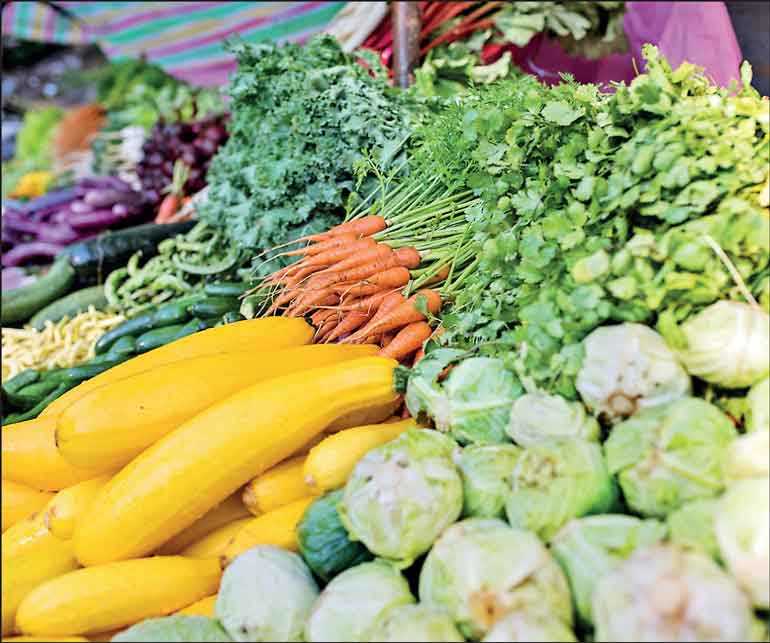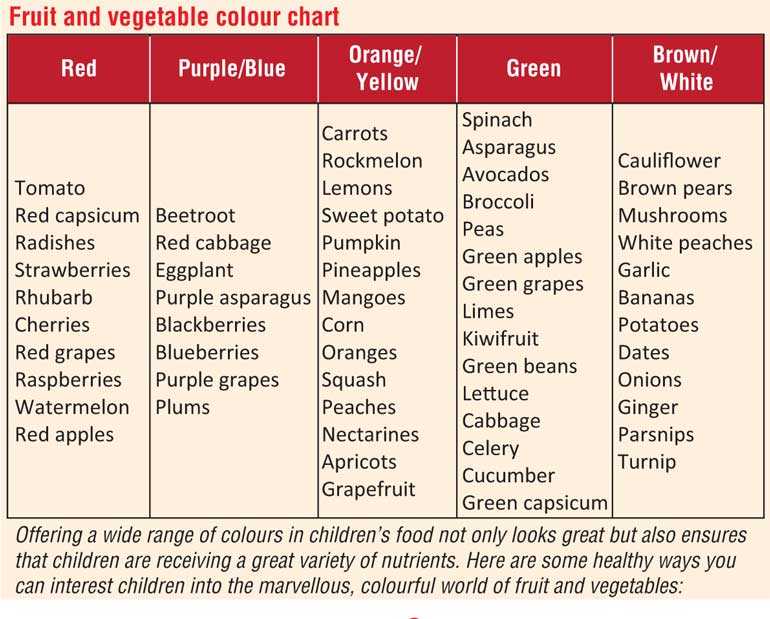Thursday Dec 12, 2024
Thursday Dec 12, 2024
Friday, 28 August 2020 00:00 - - {{hitsCtrl.values.hits}}

Sri Lanka local vegetable stall

It is found that when some food is laid before them, people eat three times. First with their eyes, eagerly searching for colour and variation on the plate, secondly with the nose searching for familiar smells and also the wonderful aromas that come from the addition of spices and herbs and lastly taste with the mouth.
So what gives colour to a plate? The many yellow and other green or red vegetables such as tomatoes, green leaves (in Sri Lanka one can find over 250 varieties of green leaves), yams, tubers, even meat, fish, eggs, pulses and importantly fruit purple, yellow, orange, red, green.
The Dietary Diversity Score is important as a checklist to ascertain if people are eating food from a number of food groups. In turn ensuring that planned meals include different food groups that provide the different macro and micronutrients the body requires for overall wellbeing. The definition of dietary diversity is “a quantitative number of food groups used extensively as a method for ascertaining variety and nutrient adequacy of diets. Dietary diversity which is defined here is the number of different food groups represented in all meals consumed over a given reference period, has been identified as a potentially useful indicator to check what people are eating.”
Many countries across the world including Sri Lanka have a set of dietary guidelines known as the Food Based Dietary Guidelines (FBDGs). The FBDGs provide country-specific advice on foods, food groups and dietary patterns to provide the required nutrients to the general public to promote overall health and prevent chronic diseases. Presently, the Ministry of Health and Indigenous Medical Services in Sri Lanka with the support of the Food and Agriculture Organization of the United Nations (FAO) and the Nutrition Society of Sri Lanka is revising the existing FBDGs (first published in 2002) in-line with current scientific evidence on the state of health and nutrition in the country.
The guidelines are formulated in such a way that food from all food groups are consumed in a routine, just like saying one’s prayers or having a bath. Eating for the sake of hunger, to fill one’s stomach will not provide the health status required.
So what are these food groups and how are they related to the different nutrients required by the body? Food groups are classified according to the major nutrients it contains, look, feel and taste.
(a) Cereals and (b) Yams are main sources of carbohydrates or starches
(c) Meat, Fish, Eggs, (d) Milk and Dairy products and (e) Pulses, provide proteins and minerals
(f) Fat and Oil are also essential in smaller quantities. Fish oil is particularly good but meat fat should be eliminated.
(g) Nuts also known as oil seeds are high in fibre, low in fat and have other key minerals and vitamins.
(h) Vegetables and Green leaves, and (i) Fruits provide a source of vitamins, minerals, fibre and natural sugars.
(j) Drinks especially water
Now what adds colour to the plate of food and the accompaniments? This is a rainbow of colour provided by the Vitamins and Plant antioxidants as well as other phytonutrients in fruit and vegetable, and partly in pulses. The consumption of more vegetables and fruits results in more nutrients and those happy plant chemicals occurring naturally. These bring different health benefits. The Elderly, Adults and Young People above 18 years should consume food from at least six food groups every day.
Let us turn to a few examples; a meal containing 2 to 3 tablespoons of pumpkin would contribute a greater proportion of the Vitamin A and its precursors as well as a relatively high amount of iron, Vitamin C and plant nutrient such as lutein, which is good for eye health. This adds a nice colour of bright yellow. Pumpkin seeds also contain Zinc, Vitamin E and healthy oils.
The way that a variety of food and colour are promoted by different countries:
South Africa: Five a day, every day – 3 types of vegetables and 2 types of fruit.
Australia: Eat a rainbow
Eat a rainbow
Fruit and vegetables fall into five different colour categories: red, purple/blue, orange, green and white/brown. Each colour carries its own set of unique disease fighting chemicals called phytochemicals. It is these phytochemicals that give fruits and vegetables their vibrant colour and of course some of their healthy properties.
What’s in a colour?
Red
Red fruits and vegetables are coloured by a natural plant pigment called lycopene. Lycopene is a powerful antioxidant that can help reduce the risk of cancer and keep our heart healthy.
Purple/blue
The plant pigment anthocyanin is what gives blue/purple fruits and vegetables their distinctive colour. Anthocyanin also has antioxidant properties that protect cells from damage and can help reduce the risk of cancer, stroke and heart disease.
Orange/yellow
Carotenoids give this group their vibrant colour. A well-known carotenoid called Betacarotene is found in sweet potatoes, pumpkins and carrots. It is converted to vitamin A, which helps maintain healthy mucous membranes and healthy eyes. Another carotenoid called lutein is stored in the eye and has been found to prevent cataracts and age-related macular degeneration, which can lead to blindness.
Green
Green vegetables contain a range of phytochemicals including carotenoids, indoles and saponins, all of which have anti-cancer properties. Leafy greens such as spinach and broccoli are also excellent sources of folate.
Brown/white
White fruits and vegetables contain a range of health-promoting phytochemicals such as allicin (found in garlic) which is known for its antiviral and antibacterial properties. Some members of the white group, such as bananas and potatoes, are also a good source of potassium.
FAO Activity Book – Eating healthy matters
Discover a world of healthy diets and nutritious food through a wide-range of facts, figures and fun activities.
Create your own fruit and veg rainbow
A great way to keep track of the colours children eat each day is to create a fruit and veg
rainbow poster. Every time the children eat a colourful fruit and vegetable they can place a corresponding coloured sticker on the rainbow or get them to colour in a small section on the rainbow. This is also a great activity that parents can do with their children at home.
Create a rainbow on your plate
Make a tropical rainbow fruit salad with fruits of each colour: oranges, strawberries, mango, rockmelon, kiwifruit, bananas, and blueberries. Stir fry your own mix of vegetables using each colour: red onions, carrots, baby corn, broccoli and mushrooms.
Read a book – I can eat a rainbow by Annabel Karmel
I can eat a rainbow teaches kids how to eat healthily by enjoying a ‘rainbow’ of food, from purple plums to red apples to greens like spinach and celery. Each two-page spread focuses on food of a different colour.